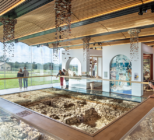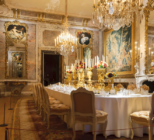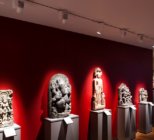Fixtures from CLS assist to enlighten the impossible in Kunstmuseum Den Haag, during the exhibition Escher – Other World.
With 160,000 works of art, Kunstmuseum Den Haag is one of Europe’s most prominent art museums. The museum in The Hague has a leading collection of modern and contemporary fine art, fashion, and applied art. With artworks by the artists Mondrian, Monet, Picasso, Kandinsky, Sol LeWitt, Francis Bacon, Louise Bourgeois, and many others, a trip to this museum is a memorable and meaningful experience.
The Kunstmuseum often opens new exhibitions. From February until September 2023, you were able to visit the exhibition Escher – Other World in the museum. This exhibition was created, because it has been 125 years since the popular and versatile artist Maurits Cornelis Escher was born. And after all these years, this artist still inspires people of all ages around the globe, including mathematicians, architects, artists, and art lovers.
In the exhibition, you were able to experience the work of Escher as never before. His famous prints were combined with spectacular installations by the Belgian architect and artist duo Gijs Van Vaerenbergh.
Escher’s prints were the result of his unprecedented talent and his almost obsessive devotion to the art of printmaking. His work, like that of Gijs Van Vaerenbergh, explores the boundaries of space, landscape, perspective, and illusion. While Escher explored on paper, Gijs Van Vaerenbergh do so in spatial installations.
For this exhibition, the core element of which was a cross-section of the work of M.C. Escher, Gijs Van Vaerenbergh had devised space-filling interventions, sculptures based on the notions of light and heavy, temporary, and eternal, impossible architecture and infinity, which are also fundamental elements in the work of Escher.
To best highlight these outstanding works of art, the museum asked lighting design firm Beersnielsen to design the light in the exhibition. The museum asked Beersnielsen already in 2017 for a light design, and since Beersnielsen has designed multiple exhibitions per year. Sjoerd van Beers: ‘We are regularly asked to illuminate exhibitions in Kunstmuseum Den Haag: we usually do this with the existing rail spotlighting. Sometimes, as with the Escher exhibition, we think about – and design, a tailor-made lighting solution for specific components.’
This exhibition spread through fourteen rooms, where in two the regular track fixtures could not be utilized. ‘In this specific exhibition, the fact arose that the spatial, architectural installations, designed by the Belgian architect duo Gijs Van Vaerenbergh, made it unattainable to illuminate the works on the walls from the ceiling using rail spotlights’, said Sjoerd van Beers.
In one of the two rooms focused on the theme of nature, the Belgian duo created a hanging installation called ‘Inverse Landscape’ by installing over a hundred sheets of paper which had been cut by hand. They all hung parallel to each other, and each sheet had a different shape. This resulted in a sort of landscape drawing that could be interpreted as clouds, water or a drawing of a hilly landscape, explained artist Arnout Van Vaerenbergh.
In the other one of the two focused on patterns, the prints of Escher were put in the installation of the duo, which created a confrontation between the two. The installation called ‘Tessellation Maze’ was made of blue punched steel screens that were open and transparent, which resulted in unique views and vistas. Sometimes you would see a print through 4 or 5 screens, while at other times you would be directly confronted with the prints, says artist Pieterjan Gijs.
Due to the installation on the ceiling, and by putting the artworks in the installation, the rail spotlights could not illuminate the works of art precisely. That is why Beersnielsen searched for a suitable supplementary solution with the Technical department Buildings & Installations and the Department Building & Furnishing of the art museum. For this solution, a compact LED spot was the best suitable solution. Sjoerd said: ‘We were looking for a compact LED spot, with an external driver, preferably a spot that would allow us to adjust the beam after installation. After a test on location with the Focus Micro from CLS, we opted for its bigger brother, the Focus GIII.’ With a zoom range from 10° to 70° and an even beam with soft edges, the Focus GIII was perfect for this application where precision lighting with more light output was required.
Kunstmuseum Den Haag made the 45 Focus GIII fixtures best suit the rooms by altering them. In the room with the installation ‘Inverse landscape’ they put the fixtures on custom-made magnetic pendants, and in the room with the installation ‘Tessellation Maze’ they colour matched the fixtures with the blue maze.
Apart from the architectural installations, these alterations were not the only challenges for the light design firm: ‘Custom pendants for the room with the ceiling installation, but also the low lux-requirements for the prints combined with the wish to make it feel as much as possible as “daylight-lit rooms”’ says Sjoerd. Together with the Technical Department of the museum, they solved these challenges. The exhibition took nearly two years to create, but the result was eye-catching, Sjoerd: ‘The architectural design of the exhibition gave you the feeling that you were walking around in an Escher print!’










